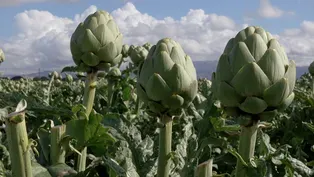
San Diego Flower Farm
Clip: 6/30/2023 | 5m 45sVideo has Closed Captions
Journey up steep terrain in San Diego County to see how farmers grow protea flowers.
Journey up steep terrain in San Diego County to see how farmers grow protea flowers for bouquets. Protea flowers grow as weeds in their native Africa, but here in Southern California, more than 250 varieties of Proteas can be found. And they're as varied as the Greek God they're named after.
Problems with Closed Captions? Closed Captioning Feedback
Problems with Closed Captions? Closed Captioning Feedback
America's Heartland is presented by your local public television station.
Funding for America’s Heartland is provided by US Soy, Sustainable Agriculture Research and Education, Rural Development Partners, and a Specialty Crop Grant from the California Department of Food and Agriculture.

San Diego Flower Farm
Clip: 6/30/2023 | 5m 45sVideo has Closed Captions
Journey up steep terrain in San Diego County to see how farmers grow protea flowers for bouquets. Protea flowers grow as weeds in their native Africa, but here in Southern California, more than 250 varieties of Proteas can be found. And they're as varied as the Greek God they're named after.
Problems with Closed Captions? Closed Captioning Feedback
How to Watch America's Heartland
America's Heartland is available to stream on pbs.org and the free PBS App, available on iPhone, Apple TV, Android TV, Android smartphones, Amazon Fire TV, Amazon Fire Tablet, Roku, Samsung Smart TV, and Vizio.
Providing Support for PBS.org
Learn Moreabout PBS online sponsorship♪♪ You'll find them dotting more than 200 acres of steep, rocky hillside in the small San Diego County town of Rainbow, a type of flower growing many people may not have ever heard of.
[Diana Roy] I say "pro-TEE-uh" but I know there are some who- in other countries that refer to it as "pro-TAY-uh."
Diana Roy is the marketing manager for Resendiz Brothers Protea Growers.
Her job includes educating the public about these unique flowers that made their way to the U.S. market in the 1960s.
Diana says Proteas actually date back millennia.
[Diana] Well, they're the oldest flowers on earth, or one of the oldest plants on earth.
They are very, very exotic.
Um, there's so many different varieties.
They were named Protea after the God Proteus, who could kind of change his image.
They grow as weeds in their native Africa, but here in Southern California, more than 250 varieties of Proteas can be found, as varied as the Greek God they were named after.
[Diana] Uh, most people are amazed.
Uh, a lot of people don't think they're real.
And many, many people, when they are familiar with them, associate 'em with Hawaii.
Or maybe, um, if they've had the opportunity to visit Africa, associate it with that.
But, uh, they are grown here in California and because of its Mediterranean climate, they do very well.
Mel Resendiz learned how to grow these beautiful buds more than 40 years ago from Howard Asper Senior, the man who first brought Proteas to America.
Asper discovered in a select few places in the U.S., the climate and topography is just right for growing these exotic flowers.
[Mel Resendiz] Yeah, because the Mediterranean, uh, um, weather and this kind of climate and the soil, it's, uh, good drainage and dry.
But growing Proteas comes with plenty of challenges that require a lot of patience.
It takes five years to go from seed to a single flower.
From cuttings, it'll still take three years to see a bloom.
But soon after, one plant can bear as many as 45 flowers, and some will eventually produce hundreds of blooms from one single bush.
As for the bushes themselves, they can live for decades.
[Mel] We still have some plants that are probably 45 years.
[Producer] Amazing.
And they're still producing?
[Mel] They're still producing.
Yes.
♪♪ Between the Proteas and other flower varieties grown here- Pincushions, Leucadendrons, and Australian plants like Kangaroo Paws- Resendiz Brothers harvests a full ten months out of the year.
And that presents another, more physical challenge.
[Mel] I think I'm the only one that I'm growing, uh- using all those hills that nobody... nobody use, because it's very steep.
Harvesting includes hiking up steep mountainsides that would otherwise be unusable, trimming from sometimes towering bushes and carrying flowers that are significantly heavier than your average fresh-cut stem.
[Mel] We start first thing in the morning, uh, to harvest.
All depends on the weather.
Right now, we can harvest all day long.
But in the summertime, we have to kind of cut early and late, and put 'em in water, like, in 10 minutes.
In this part of the state, summer temperatures can reach the nineties or even hotter, making it essential to get these flowers cut and to the packing shed miles away as quickly as possible.
This is where another team of workers sort, arrange, pack and make wreaths.
Most of their flowers are shipped throughout the U.S. and Canada, where they're sold wholesale, but retail customers can buy them as well.
[Diana] We have an online store where we sell our bouquets and our gift boxes as well as our wreaths.
And we do a farmer's market every Saturday in Old Town Temecula.
It's all done with a focus on sustainability.
Clippings gathered from the packing shed and prunings in the field are turned into mulch and put back into the soil.
Being a California business, water is often in short supply, so drip lines are critical to provide just enough water to each plant.
As for fertilizers, these hardy flowers simply don't like them.
[Mel] Our flowers is almost organic because we don't use... we don't use fertili.... fertilizer or chemicals.
It's all part of what makes these exotic African flowers such a draw to those who know them.
Another reason they're growing in popularity is their longevity.
[Diana] You can enjoy an arrangement for two weeks in a fresh state.
And then, after that, you just let it dry and they dry beautifully.
And then, you have them for years.
So, it's a very unusual and unique flower.
Despite the challenges of farming these flowers, Mel says he finds peace in what he does.
And his secret to success?
Mel says it's his love of farming these steep and rocky hills year in and year out, over four decades.
[Mel] Every morning, I'm happy that I'm going to work and, uh, I get to the farm or work at the nursery or go to the packing shed and after I send my truck out, I come up to the hills and it depends if the day is hot or- I get my bottle of wine and sit in the middle of the flowers and enjoy.
♪♪
Video has Closed Captions
Clip: 6/30/2023 | 3m 54s | Meet Georgia farmers supplying “imperfect” produce to the Atlanta Community Food Bank. (3m 54s)
Caramel Apple Crisp – Farm to Fork with Sharon Profis
Video has Closed Captions
Clip: 6/30/2023 | 5m 25s | Follow along as we cook up a sweet Caramel Apple Crisp. (5m 25s)
Video has Closed Captions
Clip: 6/30/2023 | 4m 56s | Artichoke farmers reveal why you shouldn’t be intimidated by this thorny crop. (4m 56s)
Providing Support for PBS.org
Learn Moreabout PBS online sponsorshipSupport for PBS provided by:
America's Heartland is presented by your local public television station.
Funding for America’s Heartland is provided by US Soy, Sustainable Agriculture Research and Education, Rural Development Partners, and a Specialty Crop Grant from the California Department of Food and Agriculture.














